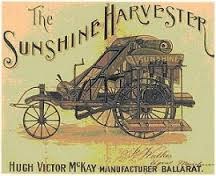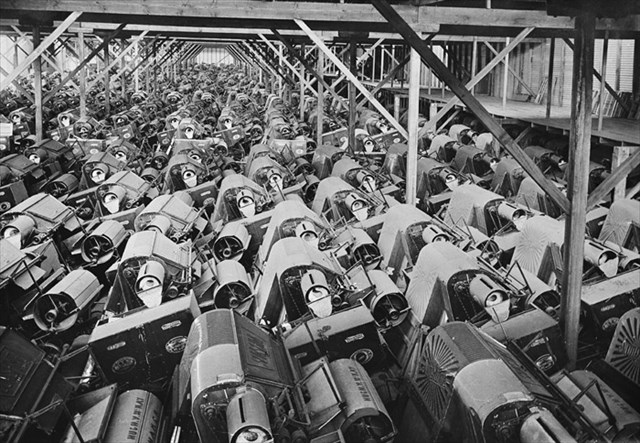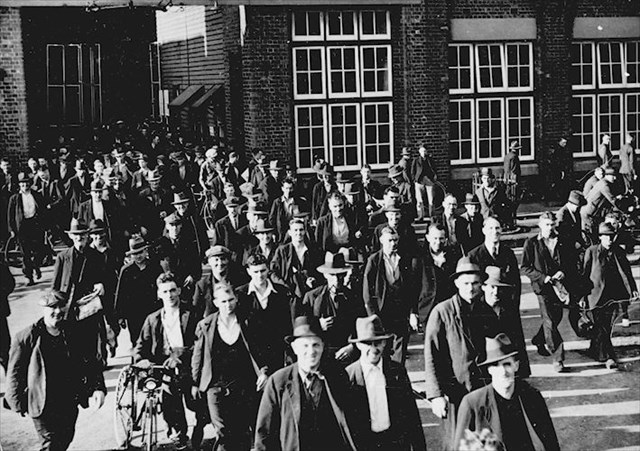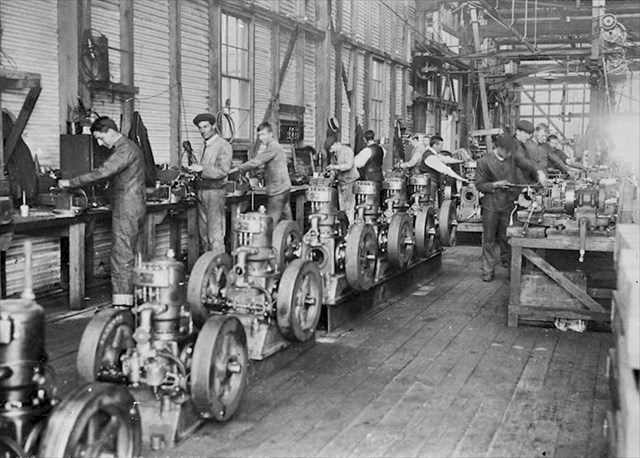H.V. McKAY Multi-cache
-
Difficulty:
-

-
Terrain:
-

Size:  (small)
(small)
Please note Use of geocaching.com services is subject to the terms and conditions
in our disclaimer.
A short multi by Team Ladava.
HUGH VICTOR McKAY, was born on 21 August 1865 at Raywood, Victoria, the fifth of twelve children. The older children had little formal schooling but all eight sons became successful businessmen, tradesmen or farmers, and four of them were closely associated with Hugh Victor's enterprise.
 McKay grew up on a farm in Drummartin near Elmore, Victoria. At the age of 18 he responded to Government incentives to produce an agricultural harvester that combined the functions of stripping, threshing, winnowing and bagging. In 1884 he developed the successful stripper harvester in a log smithy. He capitalised on its efficiency and established manufacturing works at Ballarat, before moving to Braybrook Junction (no known as Sunshine) near Melbourne in 1906.
McKay grew up on a farm in Drummartin near Elmore, Victoria. At the age of 18 he responded to Government incentives to produce an agricultural harvester that combined the functions of stripping, threshing, winnowing and bagging. In 1884 he developed the successful stripper harvester in a log smithy. He capitalised on its efficiency and established manufacturing works at Ballarat, before moving to Braybrook Junction (no known as Sunshine) near Melbourne in 1906.
 The McKay Harvesting Machinery Co., established in 1890, purchased McKay's patents and the rights to manufacture, and traded profitably until it fell victim to the economic crisis of 1892-93 and McKay was left with only £25 to his name. Assisted by a small syndicate, he snapped up the company assets and continued trading as The Harvester Co.
The McKay Harvesting Machinery Co., established in 1890, purchased McKay's patents and the rights to manufacture, and traded profitably until it fell victim to the economic crisis of 1892-93 and McKay was left with only £25 to his name. Assisted by a small syndicate, he snapped up the company assets and continued trading as The Harvester Co.
 The business expanded phenomenally and by the end of the century. 'Sunshine' harvesters were dispatched to South Africa, and in 1901 Sam and three Ballarat experts went to the Argentine where they demonstrated 'La Australiana' on a variety of crops so effectively that they soon threatened the trade in North American reaper-binders and headers.
The business expanded phenomenally and by the end of the century. 'Sunshine' harvesters were dispatched to South Africa, and in 1901 Sam and three Ballarat experts went to the Argentine where they demonstrated 'La Australiana' on a variety of crops so effectively that they soon threatened the trade in North American reaper-binders and headers.
 McKay farm machinery was sold internationally. Sunshine Harvester Works developed Australia’s early export markets to Argentina, Chile, New Zealand, Russia and South Africa. By mid-1904 McKay's overseas trade had earnings of £70,000, making him the largest manufacturing exporter in the Commonwealth.
McKay farm machinery was sold internationally. Sunshine Harvester Works developed Australia’s early export markets to Argentina, Chile, New Zealand, Russia and South Africa. By mid-1904 McKay's overseas trade had earnings of £70,000, making him the largest manufacturing exporter in the Commonwealth.
 In 1904, alerted by his brother William, manager of the Commercial Bank at Footscray, McKay acquired the well-equipped works of the Braybrook Implement Co. at Braybrook Junction. In 1907 the name Braybrook Junction was changed to Sunshine in recognition of the importance of McKay’s industrial works to the locality. McKay’s business vision encompassed not only the creation of an industrial complex at Sunshine but the development of a thriving community.
In 1904, alerted by his brother William, manager of the Commercial Bank at Footscray, McKay acquired the well-equipped works of the Braybrook Implement Co. at Braybrook Junction. In 1907 the name Braybrook Junction was changed to Sunshine in recognition of the importance of McKay’s industrial works to the locality. McKay’s business vision encompassed not only the creation of an industrial complex at Sunshine but the development of a thriving community.
 The Sunshine Harvester Works was for many years the largest factory in Australia, and it grew prodigiously to cover 30 acres (12 ha), employ 2500 workers and in 1926 distribute £600,000 in wages and salaries. The complex was completely self-sufficient, manufacturing every item required including metal tubing, nuts and bolts, woodwork, and even the bikes used by plant supervisors. Mass-production techniques reduced labour costs and increased McKay’s competitive edge.
The Sunshine Harvester Works was for many years the largest factory in Australia, and it grew prodigiously to cover 30 acres (12 ha), employ 2500 workers and in 1926 distribute £600,000 in wages and salaries. The complex was completely self-sufficient, manufacturing every item required including metal tubing, nuts and bolts, woodwork, and even the bikes used by plant supervisors. Mass-production techniques reduced labour costs and increased McKay’s competitive edge.
 In reality, McKay had a complex relationship with his workers and organised labour. He respected his employees as individuals but was strongly opposed to radical unionism. Conflict erupted with the Harvester Works Strike in 1911, when McKay supported 12 of his workers who refused to join the Agricultural Implement Makers Union.
In reality, McKay had a complex relationship with his workers and organised labour. He respected his employees as individuals but was strongly opposed to radical unionism. Conflict erupted with the Harvester Works Strike in 1911, when McKay supported 12 of his workers who refused to join the Agricultural Implement Makers Union.
 War materials were produced on a considerable scale and McKay initiated the production of drawn steel shafting and brass and copper tubing, supplying the latter widely to industry. He and Sam were members of the Federal Munitions Committee, and McKay served on the board of business administration formed in 1918 to advise the contract and supply board of the Department of Defence. While in London during 1919 he chaired the Australian War Materials Disposal Board. For these services he was appointed C.B.E. The last 100 years have seen changes to the name of the McKay Company, highlighting the shift towards a global economy, changing fortunes in the agricultural industry, and increasing foreign ownership and control. McKay left his Sunshine home in 1922 when he achieved his long-held ambition of owning Rupertswood at Sunbury.
War materials were produced on a considerable scale and McKay initiated the production of drawn steel shafting and brass and copper tubing, supplying the latter widely to industry. He and Sam were members of the Federal Munitions Committee, and McKay served on the board of business administration formed in 1918 to advise the contract and supply board of the Department of Defence. While in London during 1919 he chaired the Australian War Materials Disposal Board. For these services he was appointed C.B.E. The last 100 years have seen changes to the name of the McKay Company, highlighting the shift towards a global economy, changing fortunes in the agricultural industry, and increasing foreign ownership and control. McKay left his Sunshine home in 1922 when he achieved his long-held ambition of owning Rupertswood at Sunbury.
 McKay's health deteriorated in 1925. Extensive tests in London confirmed terminal cancer. McKay received the verdict with great courage, continuing his business and public duties to within days of his death. After McKay’s death in 1926 the company was gradually absorbed by various global corporations (Massey Ferguson, Iseki and Agco) and stopped manufacturing equipment in the 1980s. http://img.geocaching.com/cache/30d669e8-fa0a-4beb-8609-3ccb15194963.jpg On to the cache. To find the prize – If the ‘Date of birth of their daughter’ is 1886 then go to S 37° 35.255, E144° 43.951 If the ‘Date of birth of their daughter’ is 1893 then go to S 37° 35.270, E144° 43.967 If the ‘Date of birth of their daughter’ is 1891 then go to S 37° 35.287, E144° 43.976 Enjoy.
McKay's health deteriorated in 1925. Extensive tests in London confirmed terminal cancer. McKay received the verdict with great courage, continuing his business and public duties to within days of his death. After McKay’s death in 1926 the company was gradually absorbed by various global corporations (Massey Ferguson, Iseki and Agco) and stopped manufacturing equipment in the 1980s. http://img.geocaching.com/cache/30d669e8-fa0a-4beb-8609-3ccb15194963.jpg On to the cache. To find the prize – If the ‘Date of birth of their daughter’ is 1886 then go to S 37° 35.255, E144° 43.951 If the ‘Date of birth of their daughter’ is 1893 then go to S 37° 35.270, E144° 43.967 If the ‘Date of birth of their daughter’ is 1891 then go to S 37° 35.287, E144° 43.976 Enjoy.
Additional Hints
(No hints available.)